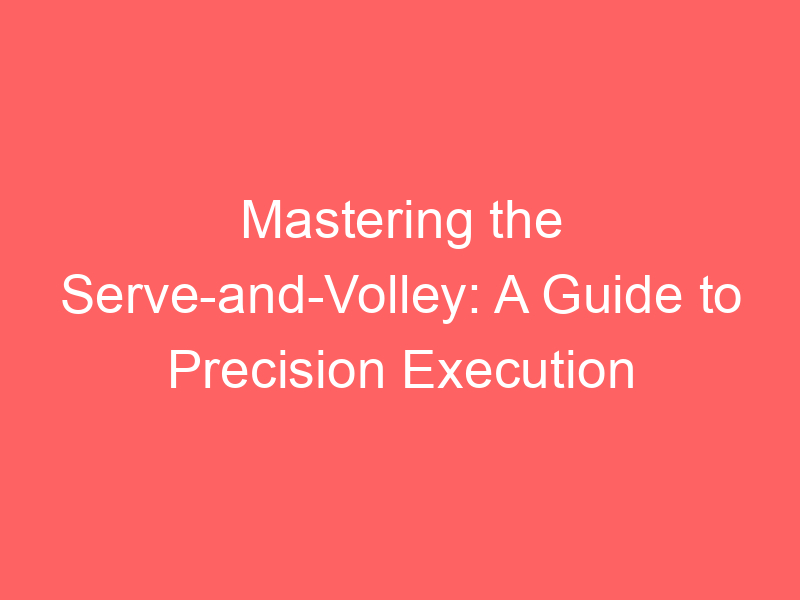
Introduction to Tennis Serve-and-Volley Strategy
Welcome to our comprehensive guide on the serve-and-volley strategy in tennis. This strategy is a fundamental part of the game and has been used by many successful players throughout history. In this section, we will define what serve-and-volley is, discuss its importance, and provide a brief historical overview.
-
- Definition of Serve-and-Volley
The serve-and-volley is a tennis strategy where a player serves the ball and quickly moves towards the net to make a volley (a shot hit before the ball bounces). This aggressive approach aims to put pressure on the opponent, forcing them to make a quick, often imperfect return.
-
- Importance of Serve-and-Volley in Tennis
The serve-and-volley strategy is crucial in tennis for several reasons. Firstly, it allows players to take control of the point early, dictating the pace and direction of the game. Secondly, it can surprise the opponent, breaking their rhythm and forcing them to make split-second decisions. Lastly, it adds variety to a player’s game, making them unpredictable and challenging to play against.
-
- Historical Overview of Serve-and-Volley
The serve-and-volley strategy has a rich history in tennis. It was particularly popular in the 1960s and 1970s, when grass courts were common, and the game was faster. Players like Rod Laver, John McEnroe, and Martina Navratilova were known for their exceptional serve-and-volley skills. Although less prevalent in today’s slower, baseline-dominated game, serve-and-volley remains a valuable strategy, used effectively by players like Roger Federer and Serena Williams.
In the following sections, we will delve deeper into the techniques for mastering serve-and-volley, advanced strategies, and how to perfect this approach to enhance your tennis game. Stay tuned!
Mastering Serve-and-Volley: Key Techniques
One of the most crucial elements in mastering the technique in tennis is precision. Let’s delve into understanding its role and how to improve it.
Understanding Precision in Serve-and-Volley
Precision in the serve-and-volley strategy is about placing your shots accurately. It’s not just about power; it’s about control. It’s about making the ball go exactly where you want it to go.
-
- Role of Precision in Serve-and-Volley
Precision plays an essential role in the serve-and-volley strategy. It’s the key to keeping your opponent off balance, making it harder for them to return your shots. For example, if you can serve the ball so that it lands near the lines of the service box, your opponent will have to stretch to reach it. This can open up the court for your volley.
-
- Improving Precision in Serve-and-Volley
To improve your precision in serve-and-volley, you need to practice. Start by aiming your serves at specific targets. Try to hit the same spot repeatedly. Over time, this will help you develop a feel for how to control the direction and depth of your shots. Remember, practice makes perfect.
Mastering precision in serve-and-volley can significantly enhance your tennis game. It’s not an easy skill to acquire, but with patience and practice, you can make your serves and volleys more accurate and effective.
Executing Serve-and-Volley: Step-by-Step Guide
This step-by-step guide will help you understand and execute this advanced strategy effectively.
- Preparation StagePreparation is the first step in executing a successful serve-and-volley. Position yourself correctly on the baseline, with your feet shoulder-width apart. Your grip on the racket should be firm but relaxed. Visualize your serve and the subsequent volley, planning your moves in advance. Remember, a well-planned serve-and-volley can give you a significant advantage over your opponent.
- Serving StageNow, it’s time to serve. Toss the ball high into the air and hit it at its highest point. Aim for a powerful serve that forces your opponent to return a weak shot. This will give you the opportunity to approach the net for the volley. Remember, the goal is to put your opponent on the defensive with your serve.
- Volleying StageAfter the serve, quickly move towards the net. Keep your eyes on the ball and your opponent. As soon as your opponent returns the ball, hit a volley. The volley should be quick and precise, aimed at an area of the court that is difficult for your opponent to reach. The key to a successful volley is timing and accuracy.
- Recovery StageThe final stage is recovery. After the volley, you should be ready to respond to your opponent’s next shot. Position yourself in the middle of your opponent’s possible return angles. This will allow you to reach the ball no matter where your opponent decides to hit it. Remember, quick reflexes and agility are crucial in the recovery stage.
It requires practice, precision, and strategic planning. With these steps, you can execute this advanced strategy effectively and gain an edge over your opponents.
Advanced Tennis Strategy Techniques: Serve-and-Volley
Among the various strategies in tennis, the serve-and-volley technique holds a significant place. This advanced technique requires a blend of physical prowess, mental strength, and consistent practice. Let’s delve into some practical tips to improve your serve-and-volley game.
Improving Serve-and-Volley: Practical Tips
Improving your serve-and-volley technique involves three key areas: physical conditioning, mental conditioning, and practice drills. Each of these areas plays a crucial role in enhancing your overall performance on the court.
-
- Physical Conditioning
Physical conditioning is the foundation of any sports technique. For serve-and-volley, it’s essential to build your strength, agility, and endurance. Regular workouts focusing on your core and lower body can enhance your serving power and speed. Additionally, agility drills can help improve your quick movements and transitions, which are vital for successful volleying.
-
- Mental Conditioning
Mental conditioning is equally important in tennis. The serve-and-volley technique requires quick decision-making and a strong focus. Mental exercises, such as visualization and mindfulness, can help improve your concentration and reduce performance anxiety. Remember, a calm and focused mind can significantly enhance your game.
-
- Practice Drills
Regular drills focusing on serving accuracy, volley placement, and transitioning speed can help you improve. It’s beneficial to practice under different conditions and against different types of opponents to prepare for various game scenarios.
Improving your serve-and-volley technique requires a well-rounded approach involving physical conditioning, mental conditioning, and consistent practice. By focusing on these areas, you can enhance your performance and master this advanced tennis strategy.
Mastering Serve-and-Volley: Case Studies
Now that we’ve discussed the key techniques and practical tips for mastering the serve-and-volley strategy, let’s delve into some real-life examples. We’ll look at two case studies – one of a professional player and another of an amateur player – to better understand how this strategy can be effectively applied and improved.
-
- Case Study 1: Professional Player’s Serve-and-Volley Tactics
Consider the case of a well-known professional player, renowned for their serve-and-volley game. This player, with a career-high ranking in the top 10, has won numerous titles using this strategy.
The player’s serve is powerful and accurate, often leaving the opponent scrambling. But it’s the volley that truly sets them apart. They are able to quickly transition to the net, positioning themselves to cut off the opponent’s return. Their volleys are crisp and precise, often angled away from the opponent or dropped short to draw them out of position.
This player’s success demonstrates the effectiveness of the serve-and-volley strategy when executed with skill and precision. It underscores the importance of a strong serve, quick transition to the net, and accurate volleys.
-
- Case Study 2: Amateur Player’s Serve-and-Volley Improvement
Next, let’s look at an amateur player who significantly improved their game by incorporating the serve-and-volley strategy. This player, a club-level competitor, initially struggled with consistency and power in their serve. Their volleys were often mistimed, leading to easy points for the opponent.
However, after dedicated practice and coaching, the player was able to transform their serve into a potent weapon. They worked on their footwork and timing to improve their volleys. Over time, they became more comfortable at the net and started winning more points with their serve-and-volley game.
This case study highlights the potential for improvement with the right training and practice. It shows that even amateur players can effectively use the serve-and-volley strategy to enhance their game.
Whether you’re a professional or an amateur player, mastering the serve-and-volley strategy can significantly improve your tennis game. It requires practice and dedication, but the rewards are well worth the effort.
Perfecting Serve-and-Volley: Advanced Tennis Strategies
As we delve deeper into the world of advanced tennis strategies, one of the most effective techniques that can elevate your game to the next level is the serve-and-volley. This strategy requires precision, agility, and a keen understanding of the game. Let’s explore some key takeaways to perfect this technique.
Tennis Precision Skills: Key Takeaways
When it comes to mastering the serve-and-volley, there are three crucial elements to consider: consistency, accuracy, and timing. Each of these aspects plays a significant role in executing this strategy effectively.
-
- Importance of Consistency
Consistency is the backbone of any successful tennis strategy. In serve-and-volley, it’s about delivering a powerful serve and quickly transitioning to the net, every single time. This repetitive action can put immense pressure on your opponent, forcing them to make errors.
-
- Role of Accuracy
Accuracy in serve-and-volley is two-fold. First, your serve needs to be accurate to put your opponent on the back foot. Second, your volley, the shot you play at the net, should be accurate enough to make it difficult for your opponent to return. An accurate serve followed by a precise volley can be a game-changer.
-
- Significance of Timing
Timing is everything in serve-and-volley. The moment you serve, you need to quickly move towards the net. But be careful, too early might leave you vulnerable to a passing shot, and too late might not give you enough time to react to your opponent’s return. Perfecting the timing can take your serve-and-volley game to new heights.
Mastering these precision skills can significantly enhance your serve-and-volley strategy, making you a formidable opponent on the court. Remember, practice makes perfect. So, keep practicing these skills to perfect your serve-and-volley game.
Serve-and-Volley Tactics: Examples
Let’s delve into some practical examples of successful serve-and-volley tactics. These examples will help you understand how to apply the strategies we’ve discussed in real-life tennis matches.
-
- Example 1: Effective Serve-and-Volley Tactic
One of the most effective serve-and-volley tactics is the ‘One-Two Punch’. This tactic involves a powerful serve followed by a quick approach to the net. The aim is to force the opponent to make a weak return, which you can then volley for a winning shot.
Consider the 2001 Wimbledon final where Goran Ivanisevic, a master of the serve-and-volley, used this tactic to great effect. He served powerfully, often aiming for the corners, and then quickly moved to the net. This left his opponent, Patrick Rafter, scrambling to return the serve and unable to prepare for the volley.
-
- Example 2: Innovative Serve-and-Volley Tactic
An innovative serve-and-volley tactic is the ‘Sneak Attack by Roger’ (SABR), popularized by Roger Federer. This tactic involves rushing to the net immediately after the serve, surprising the opponent and forcing them into a hasty and often inaccurate return.
In the 2015 Cincinnati Masters final, Federer used the SABR tactic against Novak Djokovic. Federer would serve and then sprint to the net, catching Djokovic off guard. This innovative tactic kept Djokovic on the back foot and allowed Federer to control the points.
These examples illustrate how serve-and-volley tactics can be used effectively and innovatively in tennis matches. By understanding and practicing these tactics, you can enhance your own game and increase your chances of success on the court.






